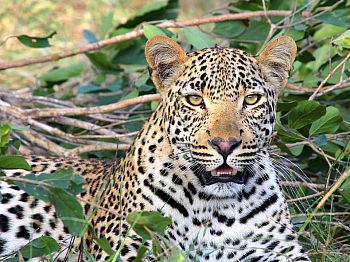Scientists find inspiration from the sea to monitor wild animal hunting in African forests
Researchers hoping to help stem the rate of unsustainable hunting in West and Central Africa have developed two monitoring indicators based in part on methods used to track populations trends of organisms in an entirely different ecosystem: the sea.
 Leopards are one of the animals hunted as bushmeat in West Africa.
Leopards are one of the animals hunted as bushmeat in West Africa.
Scientists led by a University of Sussex researcher have built on approaches used for decades to monitor exploitation levels in the world’s commercial fisheries, and on methods to track populations, to invent two indicators that will help wildlife managers monitor hunting levels on land.
Lead author Daniel Ingram, a doctoral researcher at Sussex, said: “We know that the overhunting of wild animals is perhaps the single largest threat to the biodiversity of places such as the Central African rainforest, yet these same animals provide sustenance and income for millions of people.
“Our study provides a novel method for data-driven indicators that could be used to build a comprehensive monitoring system, a foundation for conservation actions and policies.”
The researchers used two types of data on wild animal hunting from a variety of sources (such as published papers, NGO reports, master’s and doctoral theses).
The ‘snapshot data’ - information collected at a single site over a period of 18 months or less - led to the development of a metric similar to one used in fisheries, which assesses whether hunters are shifting from larger-bodied to smaller-bodied creatures over time (assuming that the shift is caused by the disappearance of larger animals).
The second indicator – informed by data gathered at the same site and time of year for a number of years - provides a metric of the hunting pressure on groups of species within a specific region over time.
The researchers used both indicators for the aggregated data for mammals and birds from West and Central Africa. They found that hunters may be switching to smaller species over time when large ones disappeared, but that the size of hunted birds increased between 1966 and 2010. During the study period, harvesting pressure on birds and mammals increased.
Conservationist Fiona Maisels, a co-author on the paper, said: “With enough data, these indicators can help us to protect wildlife while maintaining natural resource benefits for people in local and global contexts.”
Also part of the international research team was Sussex ecologist Dr Jörn Scharlemann, Interim Director of the Sussex Sustainability Research Programme and an Honorary Fellow of the United Nations Environment Program World Conservation Monitoring Centre (UNEP-WCMC).
The collaborative study, published in Ecology and Society, included researchers from the University of Sussex, University of Oxford, University College London, Manchester Metropolitan University, University of Cambridge, the Center for International Forestry Research, Fauna and Flora International, UNEP-WCMC, Zoological Society of London, and Wildlife Conservation Society.
The work was made possible by funding from the University of Sussex, U.S. Fish and Wildlife Service, USAID-CARPE, Rufford Foundation, and the UK NERC and ESRC.
